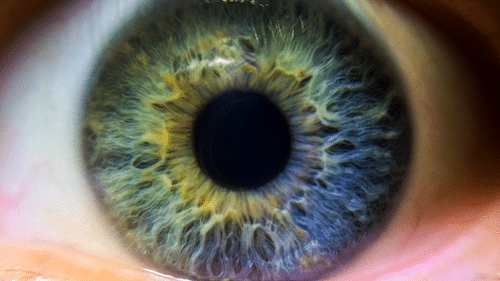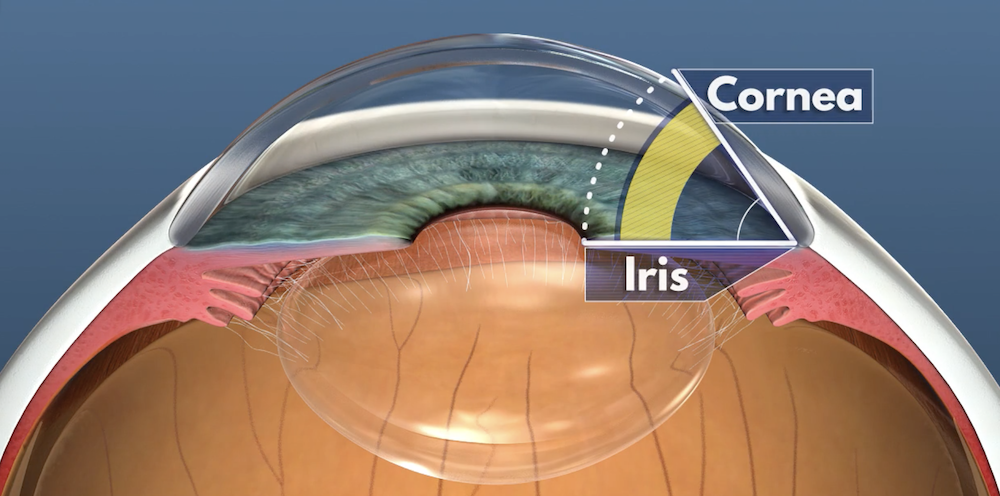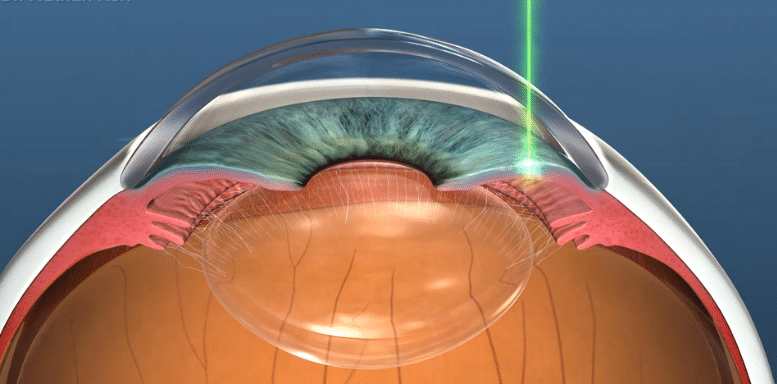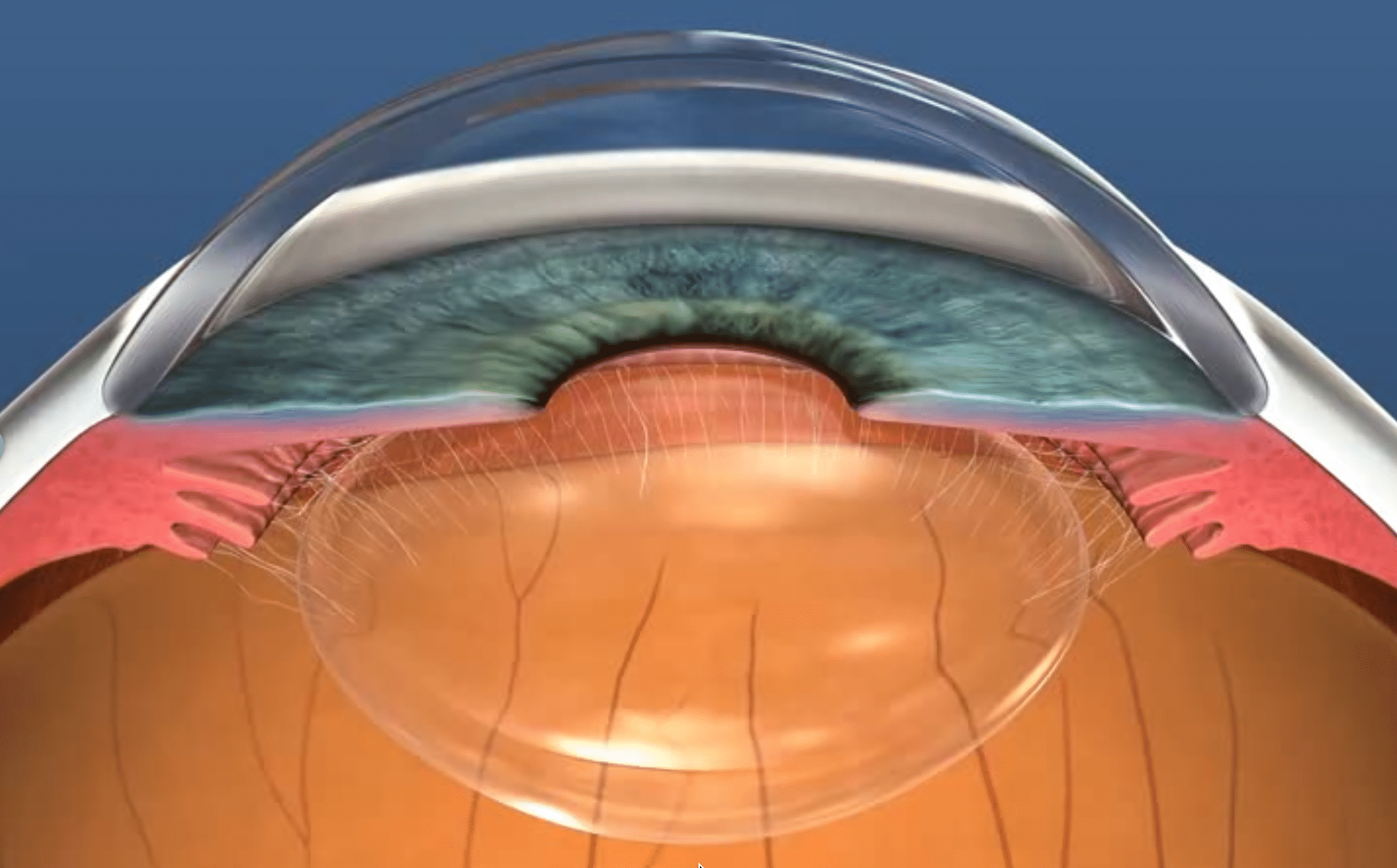
Laser iridotomy
A laser procedure used to treat or prevent angle-closure glaucoma in people with narrow angles
Learn moreLaser peripheral iridotomy
An effective, safe, and simple treatment for people with narrow angles

What is glaucoma?
Glaucoma is a group of eye diseases commonly caused by an increased pressure inside the eye resulting from a buildup of excess fluid. High eye pressure can damage the optic nerve and cause vision loss. Treatment is aimed at keeping eye pressure at a safe level to protect eyesight.

What are narrow angles?
This is where the space between the coloured part of the eye (called the iris) is too close to the clear front window of the eye (known as the cornea). The iris can block off the eye's natural drainage channel, leading to a dangerous build up of eye pressure.

Acute angle-closure is a medical emergency
People with narrow angles are at risk of acute angle closure, where the drainage channel blocks off, leading to a rapid rise in eye pressure causing severe eye pain, headaches, halos, nausea, and vomiting. Permanent vision loss can occur it not treated quickly.
If you are experiencing the symptoms of acute angle closure, seek immediate medical attention or call 000.
How to treat narrow angles
A quick, office-based, laser procedure

Laser peripheral iridotomy
Laser peripheral iridotomy is an effective, safe, and simple procedure to improve eye health for patients with narrow angles. It is performed in the office, and typically takes no more than a few minutes.
How does laser peripheral iridotomy work?
Brief pulses of laser light are used to create a tiny hole in the coloured part of the eye (called the iris) to create a new pathway for the aqueous fluid to drain. The new drainage hole allows the iris to fall back into a normal position, helping prevent the iris from blocking the eye's drainage channel.

-
Creates a new channel
A tiny channel is created in the outer edge of the colour part of the eye.
-
Equalises the pressure
The new hole equalises the pressure in front and behind the coloured part of the eye (iris), causing the iris to return to a more normal position.
-
Deepens the eyes drainage angle
The space between the iris and cornea is increased, helping relieve or prevent blockage the the eye's drainage channel.
Prevention is better than cure
Laser iridotomy can benefit people with narrow angles
Is laser iridotomy right for me?
If you have narrow angles, laser iridotomy may help relieve or prevent a dangerous build up of eye pressure and reduce your risk of glaucoma.
In a large randomised clinical study, laser peripheral iridotomy was shown to significantly reduce the risk of angle closure.

Dr Nathan Kerr
Melbourne Glaucoma SpecialistLaser iridotomy
Benefits melbourne- Only takes a few minutes
- Office procedure
- Helps avoid eye surgery
- Reduces the risk of glaucoma
- Usually does not need to be repeated
Who should have laser iridotomy?
It is necessary to first undergo an eye examination to determine if you require laser iridotomy. If you fit into one or more of the following categories, you may benefit from laser iridotomy:
Narrow angles
You have been diagnosed with narrow angles by your optometrist or ophthalmologist.
Symptoms of angle closure
You are are having symptoms of angle closure such as headaches, eye pain, or intermittently blurred vision.
Taking certain medication
You are taking certain medications, including over-the-counter cold or pain medication, that can cause your pupil to dilate and block off your drainage angle.
Require regular dilation
You have diabetes, macular degeneration, or another eye condition which requires your eyes to be dilated with eye drops.
Experienced Glaucoma Specialist
Dr Nathan Kerr has performed thousands eye laser procedures and regularly audits his results to ensure he is delivering the best results.
book an appointment
Frequently asked questions
Learn more about laser iridotomy
What is laser iridotomy?
Laser iridotomy is an effective, safe, and simple treatment for people with narrow angles.
What are the benefits of laser iridotomy?
People with narrow angles are at risk of angle-closure glaucoma. This can occur in one of two ways. Either suddenly, with a rapid rise in eye pressure causing headaches, nausea, and blurred vision. Or gradually over time with few symptoms. Left untreated, damage to the optic nerve can occur and result in vision loss. Laser iridotomy significantly reduces the risk of either a sudden or gradual build up of eye pressure.
What happens during the laser iridotomy procedure?
Prior to treatment, eye drops are administered to prepare and numb your eye. You may experience mild eye pain or a headache from one of these eye drops, which causes your pupil to constrict. Then, brief pulses of light are delivered through a specially designed microscope to the coloured part of the eye. You will feel a brief sensation as the procedure occurs. The entire process takes just a few minutes. When it's complete, you will have your eye pressure checked and you will be able to go home 30 minutes later.
What happens after the laser iridotomy procedure?
Your vision may be blurred and you should have somebody drive you home. You will be given anti-inflammatory eye drops to use for one week. Most people are able to return to work the following day. However, if you require time off work, Dr Kerr can provide a medical certificate.
What will I experience after laser iridotomy?
You may have mild eye redness and sensitivity to light for a few days following the procedure. These symptoms rarely cause harm and you will be monitored after the treatment.
What are the risks?
The procedure overall is very safe. There is a small risk of raised eye pressure immediately after the procedure. To lower this risk, you will be given eye pressure lowering drops before the procedure. Your eye pressure will be measured after the procedure and if necessary, you will be given eye pressure lowering medication to take home.
Serious problems after laser iridotomy are very rare. These include bleeding from the colour part of the eye, inflammation inside the eye, or swelling of the front window of the eye. These problems usually resolve on their own but can be treated if required.
Occasionally, patients can experience visual symptoms from light entering through the laser iridotomy. These symptoms usually improve with time and are rarely bothersome.
Do I need to have have both eyes treated?
Narrow angles usually affects both eyes. Therefore both eyes usually receive treatment, either on the same day, or a few weeks apart.
Do I need to have the procedure repeated?
The procedure does not normally need to be repeated, as the iris does not heal like the skin and the hole remains open permanently. Occasionally, the the hole created by the first procedure may be need to be enlarged.

